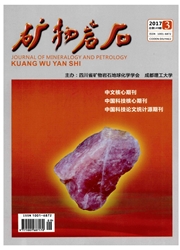

 中文摘要:
中文摘要:
宁芜盆地娘娘山组钾质火山岩为盆地内中生代最晚期火山喷发形成的火山岩,其矿物成分中钾长石主要为透长石;辉石均为透辉石;黑云母为镁质黑云母,黑云母结晶温度为650℃~750℃,氧逸度(logfo2)约为-12~-10。这些矿物的化学特征与庐枞钾质火山岩中矿物的化学特征非常接近,综合其全岩地球化学、同位素年龄数据,表明娘娘山组钾质火山岩形成于造山后的构造环境。对黑云母的成分分析表明其岩浆来源较深,应为幔源岩浆分异演化的产物,并推测与地壳发生了较弱的同化混染作用,同时娘娘山组钾质火山岩的岩相学和矿物化学特征揭示了其岩浆演化的过程。
 英文摘要:
英文摘要:
Abstract: The volcanic rocks of the Niangniangshan (NNS) Formation were formed by the lat- est phase of the Mesozoic volcanic activities in the Ningwu Basin. Mineralogical characteristics have been studied and the following conclusions have been obtained. K-feldspar in NNS Formation was mainly sanidine, clinopyroxene was all diopside and biotite was Mg-biotite. The crystallization temperature (T) and oxygen fugacity (logfo2) of the biotite was 650 ℃ -750 ℃ and -12--10 respectively. The chemical characteristics of these minerals were similar to those of the minerals in potash-rich volcanic rocks in Luzong Basin. Geochemical data of whole rock major elements and isotopic age of the volcanic rocks of the Niangniangshan Formation indicated that they were formed in a post-orogenic tectonic setting. Electron microprobe analysis data of the biotite showed that the source of the magma was relatively deep and the volcanic rocks were the product of the fractional crystallization of the magma from the mantle. It was also indicated that slight contamination by crustal material during magma ascending occurred. In addition, petrographic and mineralogical characteristics of NNS Formation revealed the magma evolution.
 同期刊论文项目
同期刊论文项目
 同项目期刊论文
同项目期刊论文
 期刊信息
期刊信息
